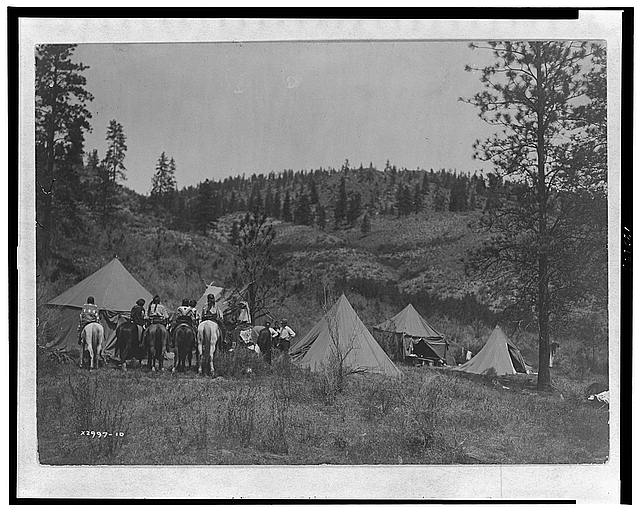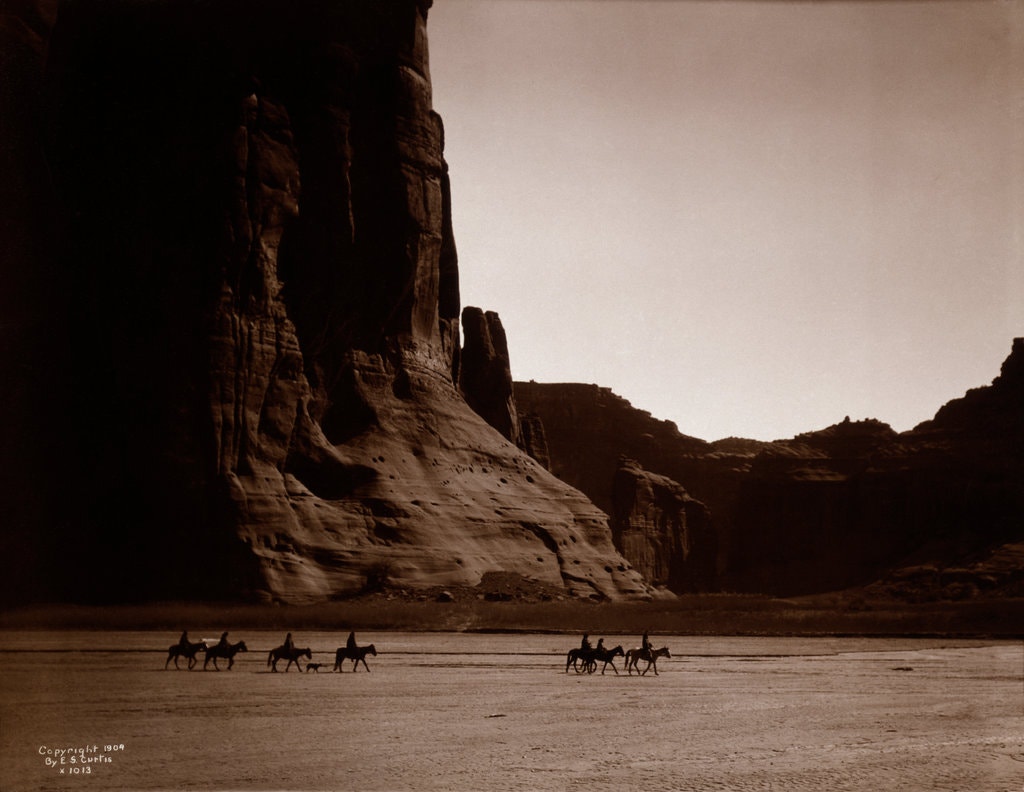Learn about photographers who recorded images of Native Americans of the American West, and do some comparing and contrasting.
Welcome to the Episode 121 Page

In the last episode, we learned about intrepid artists who drew and apinted Native Americans. Notably, painter George Catlin travelled throughout the American West, residing with tribe after tribe, painting landscape, fauna, and most importantly, Native American individuals. Catlin dedicated his life to preserving Native American life and culture on canvass before control by the United States caused them to drastically change.

In this episode, we feature those who came into the American West with a similar mission, albeit with different tools. Photographers took up the mission of documenting Native American life following the Civil War. While early photographers approached the task with a more technical angle, later photographers sought to utilize artistic qualities in their work. Edward S. Curtis was especially dedicated to this mission, working his entire lifetime to use photography to bring the world accurate images with an artistic flare.

Like Catlin, Curtis rendered images that reflected the humanity of his subjects. Curtis also undertook ethnology work which he combined with his photos to produce a 20-volume set on Native Americans of the Western United States. He also produced sound recordings, capturing American Indian speech, stories, and songs from many individual tribes.

This Episode of Ramping Up your English features a video of the work by these photographers.
Viewing Episode 121
You can watch Episode 121: Images on Glass from archive.org. Just click here to see the video. You can also download the episode from here.
Episode Summary
By the end of the Civil War, the new technology of photography brought images to the public of battlefield events. This technology was brought out West to produce a record of the region as it existed at the time. This included images of Native American communities, including indigenous individuals.
Publications back East found interest among readers about the western region of the United States and featured these photos. Between this demand and government efforts to document this poorly-known region, photographers such as John Karl Hiller, Ben Wittic, John C. Greybill, and William S. Soule found paying customers for their work.
At the end of the 19th Century, Photographer Edward S Curtis began an endeavor to introduce artistic elements into his photography. Having established himself as a successful portrait photographer in Seattle, Curtis embraced a mission to document Indian life and customs before those faded away due to assimilation pressures.
Cutis undertook this expensive effort, dedicating his life to photographing Indian life, customs, and individuals with amazing quality. He kept a written record of what he learned from interviews with the subjects of his photos and community members where he did his work. Curtis also recorded over 2000 wax cylinders of language, songs, and stories from the numerous Tribes with which he visited.
Curtis produced a masterpiece of Photos and information in the form of a 20-book set entitled North American Indians. His efforts exhausted him both financially and physically. After much hardship, his wife divorced Curtis, yet he remained close to his children, on of whom lived in Medford, Oregon.
The images that Native Americans had of themselves had been rendered on rock art, but artists from Europe and those of European decent made their own images. These rendering become more realistic as more artists invested in works of greater accuracy. Native American artists, like Richard Throssel paved the way for native artists to produce their own body of work.
Videos Used in this Episode
Click here to see the featured video on my You Tube channel. There may be ads on You Tube. A rather long video supplied the content of this episode and the previous episode, simply entitled Images. Click here to see the expanded version on archive.org.
Links to Related Videos
In this section, you can enjoy videos from toher sources that celebrate the works of photographers capturing images of Native Americans, especially of Edward S. Cutis. These You Tube videos probably come with ads. Click here to see a video about Curtis from Lombary Productions. Click here to see a video about Curtis from Makepeace Productions. Click here for a short video from Makepeace productions – the Bringing of the Branches for the Sun Dance. An excellent production about Edward S Curtis is on the You Tube Channel of Haidi St. George. Click here to watch it. Click here to see a lecture about Curtis during an exhibit at the University of Minnesota. Click here for a trailer for In The Land of the Headhunters by Curtis from Milestone films. Click here for a beautiful little video about the work Curtis did for the Native Americans of the Pacific Northwest from Cognocentrics. Click here for a short video entitled The Shadow Catcher.
Links to Curtis Resources
Click here to find works by and about Edward S. Curtis on archive.org. It’s an extensive and deep collection of works, including his monumental 20-volumes set The North American Indian.
Suggested Homework
Viewers who have seen our recent episodes may notice similarities between artists George Catlin and Edward S. Curtis. This is a great opportunity to write a few paragraphs comparing and Contrasting these individuals and their works. Let’s ramp up the function words and phrases we use to Compare and Contrast.
Here are few sentence stems you can use to compare.
Some similarities are….
Their approaches have much in common in that….
They shared a sense of mission, that ……
A common trait was that ……
Here’s some phrasing for contrasting...
While Catlin ______________, Curtis ________
While their goals were similar, the technology differed in that……
The stages of assimilation were distinct. Whereas Catlin encountered Indians when ………….; Curtis found Native Americans in his time were ………
These can liven up the basic language of comparing and contrasting, words and phrases such as….
Both, were similar, had in common, alike
However, only, different, but, distinct
Some of our previous episodes had language function of Comparing and contrasting. This assignment builds on that basic function of telling how people or things are alike and how they are different. Catlin and Curtis give us a rich list of examples.
Next Episode
Episode 122 explores how Native Americans have accessed a place at the table where Indian Policy is made, and how members of Tribes have attained power and influence in state and federal governments and agencies. One hundred years since Native Americans won citizenship in the United States (1924 to 2014), Native voices are increasingly heard across the land. The next episode is entitled Voices. You can soon Click here to view the Episode 122 page of Ramping Up your English.